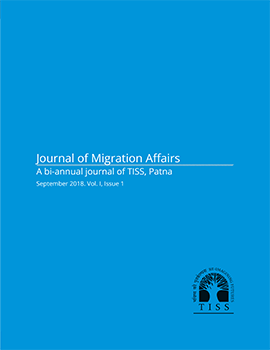1. The Journal invites unpublished, original research papers in the broad area of migration studies. Submissions that are out of the scope of the Journal or otherwise inappropriate will not be accepted.
2. Papers must not have been simultaneously submitted for publication to any other journal
or book. A declaration of this effect must accompany the submission.
3. Papers may be submitted through the link provided on the website or may be mailed to: migration.affairs@tiss.edu.
4. No fee is charged for submitting and publishing a paper under any category.
5. Papers may be submitted under five categories:
a) Article: Usually 6000-8000 words, including notes and references. Articles must be accompanied by an abstract of 150-200 words and five to eight keywords.
b) Commentary: Usually 2500-3500 words, focusing on contemporary topics/debates. It should be accompanied by an abstract not exceeding 75-100 words.
c) Review: Book, film, artwork, etc. review: Usually approx. 1500 words.
d) Review Article: Review of a group of books, films, etc., focusing on the theme rather than the works to be reviewed.
e) Contributions by Research Scholars: Full-length article (6000-8000 words, including notes and references.)
However, the Editorial Board will be free to add a new category in addition to the above-
mentioned ones.
6. Unsolicited book/film/artwork reviews will also be accepted for publication.
7. The submission should be in word format.
8. The contributors must use endnotes and NOT footnotes. However, endnotes should not be used for providing references. References for all in-text citations must be provided separately.
9. The Journal follows the in-text citation method. The submission should follow the Chicago Manual of Style (author-date) in UK English. For the style sheet, click here. Authors should not engage in excessive self-citation of their own work.
10. Graphs and charts should be prepared in MS Office (Word/Excel) and not in jpeg or other formats.
11. The contributors must cite the source of all data, figures, maps, artworks, etc.
12. Wherever copyrighted material is used in the paper, the author must produce an appropriate permission letter from the copyright holder.
13. The author must provide full details, including name, designation, current affiliation, e-mail address, and complete postal address. In the case of more than one author, the submission must mention the corresponding author.
14. It is mandatory for authors to acknowledge in the paper the source(s) of financial support, if any, including the purpose of the funding (such as undertaking the research, funding for writing or editorial assistance or travel grant.
15. Authors should disclose interests that might affect their ability to present their work objectively. These might include any financial, personal, political, or religious interests. The disclosure may also state the absence of any conflict.
16. The Journal may consider publishing a paper translated from any published or unpublished source. However, in the case of published material, the author must submit appropriate permission from the publisher and also provide a copy of the paper in the original language.
17. Authors must avoid using derogatory or offensive language in relation to caste, class, gender identity, sexual orientation, age, racial and ethnic background, disability status, etc. unless it is essential to the research in question and produced under direct quote.
18. In the case of a selected paper, if any bias or offensive expression is detected at any stage, the copyeditor will have the right to moderate the language.
19. After the copy editing, the final proof will be sent to the author who must return the proof within the specified time after reviewing the edited version and responding to specific queries and clarifications.
20. Authors should also be sensitive when using images of objects that might have cultural significance or cause offence.
21. Authors should remove all information that could identify the subject, whether in the text or image. The names of the subject must be anonymised. In the case of an image, prior-informed consent of the subject must be submitted along with the paper.

